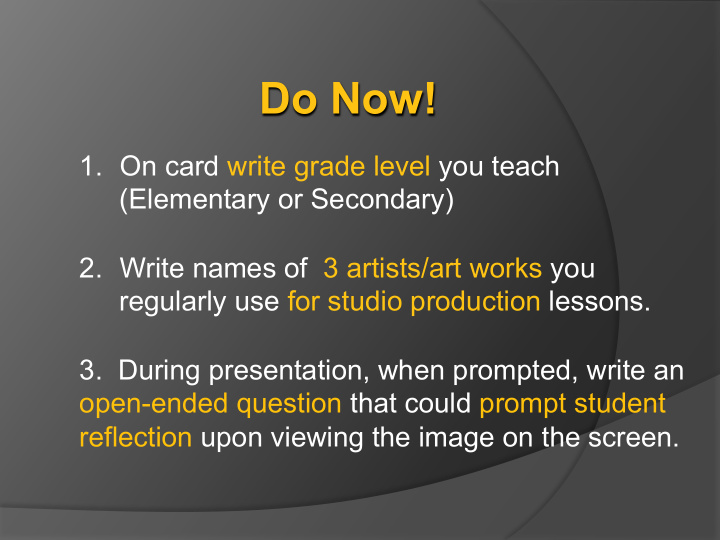



Do Now! 1. On card write grade level you teach (Elementary or Secondary) 2. Write names of 3 artists/art works you regularly use for studio production lessons. 3. During presentation, when prompted, write an open-ended question that could prompt student reflection upon viewing the image on the screen.
Contemporary Art Engages Students to Think Reflectively, Critically, and Creatively Barbara Suplee, The University of the Arts ¡ Wild Swans , Su Blackwell (2008) ¡ ¡ ¡ ¡ ¡ ¡ ¡ ¡ ¡ ¡
It’s all about their stories! ¡ ¡ ¡ ¡ ¡ ¡ ¡ ¡ ¡ ¡ ¡
Small Acts , Isaac Cordal (2010) Magic Garden , Isaiah Zagar (2012) United Buddy Bears , Santiago, Chile (2015) Magic Clemson Clay Nest , Nils-Udo (2005)
Contemporary Art…What is it? • Contemporary art is being created NOW • Artists are generally living and working • Much of today ’ s contemporary art is conceptual • It can be alienating, controversial…but • Not all of it is controversial
Hand Art , Guido Daniele (2014) Knitting with Loaded Shotguns (Safety Off), Dave Cole (2008) Carhenge , Jim Reinders (1987)
Does it belong in YOUR Classroom? • YES, it promotes dialogue, divergent thinking, and creativity • Many contemporary artists fit seamlessly into art curricula (even at elementary level!) • Some teachers feel uncomfortable including contemporary art in their curriculum • But…you can learn about it and use it effectively in your classroom
Focus of most art rooms
Mastery Learning Step-by-step, teacher-directed sketchbook assignment
The results Promotes CONVERGENT THINKING , following directions
Divergent vs. Convergent Thinking Promotes multiple solutions/ideas vs. a single solution/idea
We need both! 21st Century Skills (www.p21.org) 2014 National Visual Arts Standards (NVAS)
How can we promote Divergent thinking? Self-Directed Learners, Goal Setting, Personal Reflection
Ask open-ended, thought provoking questions Questions that lead to Ideas and the construction of meaning
Use the New (2014) Visual Arts Standards
15 Big Ideas Identified: “ Enduring Understandings ”
Focus on 4 Areas Pre-K-12 Aesthetic, Critical, and Creative Inquiry
Through concept-based inquiry and investigation of Creating 15 Enduring Understandings (Big Ideas), the new Presenting “ standards essentially ask students to step back and Responding consider art and its Connecting connections to their world– to think about art, culture, and history, in general ” (Stewart, 2014).
CREATING ENDURING UNDERSTANDING: Creativity and innovative thinking are essential life skills that can be developed. ESSENTIAL QUESTION(S): What conditions, attitudes, and behaviors support creativity and innovative thinking ? What factors prevent or encourage people to take creative risks? How does collaboration expand the creative process? PRESENTING ENDURING UNDERSTANDING: Artists and other presenters consider various techniques, methods, venues, and criteria when analyzing, selecting, and curating objects, artifacts, and artworks for preservation and presentation. ESSENTIAL QUESTION(S): How are artworks cared for and by whom? What criteria, methods, and processes are used to select work for preservation or presentation? Why do people value objects, artifacts, and artworks, and select them for presentation?
RESPONDING ENDURING UNDERSTANDING: Individual aesthetic and empathetic awareness developed through engagement with art can lead to understanding of self, others, the natural world, and constructed environments. ESSENTIAL QUESTION(S): How do life experiences influence the way you relate to art? How does learning about art impact how we perceive the world? What can we learn from our responses to art? CONNECTING ENDURING UNDERSTANDING: Through art-making, people make meaning by investigating and developing awareness of perceptions, knowledge, and experiences. ESSENTIAL QUESTION(S): How does engaging in creating art enrich people’s lives?
Use Contemporary Art Hope Hippo , Allora and Calzadilla (2005) Mud, Whistle, Daily Newspaper, Reader 16 ’ x 6 ’ x 5 ’
I Am Become Death, Shatterer of Worlds , Damien Hirst (2006) Butterflies and household gloss on canvas, 7 ’ x 17.5 ’
Wonder Space II , Toshiko Horiuchi MacAdam (2012) Hand crocheted nylon (used as an interactive play space for children)
Puppy , Jeff Koons (1992) Stainless steel, soil and flowering plants, 40 ’ 8 3/16 ” x 27 ’ 2 3/4 ” x 29 ’ 10 1/4 ”
Tar Beach , Faith Ringgold (1990)
Minga , Bastardilla (2014)
@ Large , Ai Weiwei on Alcatraz (2014) (Lego portraits of 76 “ heroes of our time ” who have been imprisoned or exiled)
Plastic Bottles , Chris Jordan (2007) (2 Million discarded plastic bottles, the number used in the U.S. every 5 minutes)
Anthony of Padua , Kehinde Wiley (2013) Oil on canvas, 72 ” x 60 ”
Maria Lengauer Philadelphia High School for Creative and Performing Arts (CAPA) 700 + Students (72% Minority Enrollment): Grades 9-12
Strike Upon Mankind
Sisla (Child in Punjabi)
Primary Distribution
In Conclusion …to promote divergent thinking, students’ deeper understanding of art, themselves, others, and their world, use: * Concept-based Inquiry* Student-centered Instruction Independent Problem-solving Self-directed Learning Journaling * List-making Free Association * Collaboration Self-reflection Self-assessment *Contemporary Art*
Thank You! • Questions? • Comments?
Recommend
More recommend